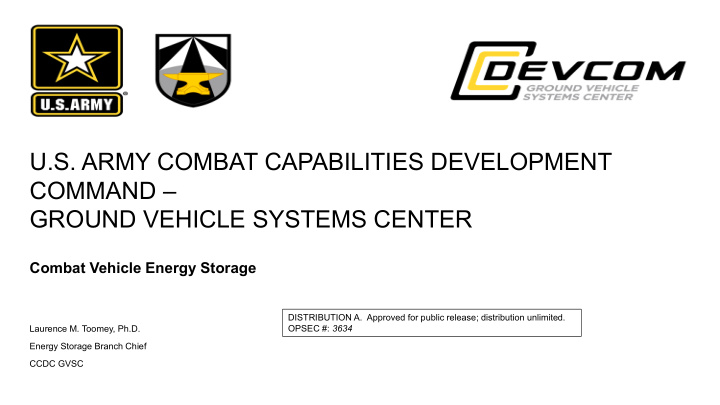



U.S. ARMY COMBAT CAPABILITIES DEVELOPMENT COMMAND – GROUND VEHICLE SYSTEMS CENTER Combat Vehicle Energy Storage DISTRIBUTION A. Approved for public release; distribution unlimited. OPSEC #: 3634 Laurence M. Toomey, Ph.D. Energy Storage Branch Chief CCDC GVSC DISTRIBUTION A. See first page. 1
COMMERCIAL VS. MILITARY REQUIREMENTS Unclassified 2 DISTRIBUTION A. See first page. 2
OTHER CONSIDERATIONS: THE NAVY’S SAFETY TESTING Challenge: The primary challenge associated with fielding Li-ion batteries on military vehicles is meeting the Navy safety certification requirements to allow the Naval transportation of Li-ion battery based energy storage systems. Currently we are working with multiple stakeholders (including Navy, DOD, PM stakeholders and battery manufactures) to define the required testing that allow for Naval transportation of Li-ion 6T batteries. Based on this approach, we will seek to gain approval to for Naval transportation of Li-ion 6T batteries. (This approach will also be implemented as we develop modular high voltage battery systems to support advanced platform electrification.) Conducted in MIL- PRF-32565 QPL Undefined for 6T Li-ion DISTRIBUTION A. See first page. 3
SAFETY UNDER UNIQUE ABUSE STIMULI Several battery containment concepts tested with ballistic penetration • Used two common military rifle calibers (AP and API types). • Fire containment bags, composite box, vented aluminum box (uncoated, and ceramic-based spray coated on inside). Prototype Test Battery (HSL7): Type 1 Battery (HSL4): Fire Containment Bag Prototype Test Battery Vented Aluminum Box (HSL4): DISTRIBUTION A. See first page. 4
ALL ELECTRIC TANK FEASIBILITY (HYBRID VS. FULL E-TANK) All Electric Tank (with Today’s Technology) ~100,000 lbs (50 ton) ~35x Range: 300 miles 11.5kWh/mile (3.4MWhr battery) Tesla Model S Battery Est. Weight: 60,100 lbs Car: ~4500 lbs Battery Est. Vol: 605 ft 3 Range: 315 miles Recharge: 3.4MW (1hr), 6.8MW (30min) or 13.6MW (15min) 100kWhr battery Tesla S Pack Battery Weight: ~1,700 lbs X ~35 (~35-40% of vehicle weight) 300 mile All Battery Required Powertrain Volume Volume = ~650ft 3 Hybrid for 300 miles (for all electric drive X ~10 Powertrain Volume = 225ft 3 components) Available Volume Available volume in the concept = 225ft 3 (Results in estimated range of ~100 miles in a military battery) DISTRIBUTION A. See first page. 5
GVSC ENERGY STORAGE ROADMAP To meet unique military requirements including Navy Safety certification, standardized/scalable military batteries are needed Includes Thermal Management Extreme Energy High Voltage (EEHV) – All Electric 600 GVSC Development Modular High Voltage FY23-27 (MHV) – Hybrid Applications GVSC Development FY20-24 Voltage (V) 300 Potential Automotive Commercial Li-ion 6T growth (300-600V) (with S&T HEV : 5+ kWh Investment to PHEV :16-20+ kWh enable series EV : 30-100++ kWh connection) Electric Trucks EV 400-500+kWhr 100 25 Current Li-ion 6T (24V, 12P configurable) MIL-PRF-32565A No cooling of batteries Li-ion 6T 25 50 100 200 500 Energy (kWh) DISTRIBUTION A. See first page. 6
MODULAR HIGH VOLTAGE (MHV) OVERVIEW Key Features: Flexible architecture to accelerate vehicle hybridization • Voltage: 50 – 600+V • Energy: 3 – 100 kWh • Scalable modules (~50V) connected in series/parallel for various applications. • Qualification to occur at the module and section level. • Some consideration for backward compatibility of current force vehicles • Full operational capabilities between -30 o C to 60 o C WITH thermal management. Reduced operation down to -46 o C or up to 71 o C or WITHOUT thermal management. • Module BMS: provides status and monitoring information for safe operation of pack, built-in tests, diagnostics and cell balancing. • Pack BMS (likely be GFE to meet unique military requirements). Reports pack status and monitoring info to vehicle digital com buses. Controls of battery thermal management, battery protection and pre-charge/main contactors. DISTRIBUTION A. See first page. 7
CONCEPT FOR STANDARDIZED 300V BATTERY SECTION Each section likely consist of 6 modules – configurable to 300V or dual 150V. Section would serve also serve as base militarized 300V battery 50V Module Pack estimated size vs reference 6T (module is approximately size of 6T) Peak 6 min Module Module Pack String Cells in Modules String Continuous Chemistry Li-ion (NMC) Voltage Energy Energy Capacity Li-ion 6T battery series in series Voltage Power @ 10C (V) (kWhr) (kWhr) (Ah) (kW) Charge voltage 4.2 14 58.8 6 352.8 Discharge 2.5 14 35 2.6 6 210 15.9 51 159 Voltage Nominal Voltage 3.7 14 51.8 6 310.8 DISTRIBUTION A. See first page. 8
MHV PROGRAM BREAKDOWN Standard module • Module deliverables: ~50V, ~2.2kWhr Section ~12-15Whr Configurable to 300V or 2x 150V • SIL pack (re-configurable 300V or “dual 150V” sections): • Optionally Manned Fighting Vehicle (OMFV) or Robotic Combat Vehicle (RCV) batteries: OMFV: 2-300V and 2-150V sections RCV: 1-300V and 1-150V sections Configured ~500V & ~40+ kWhr Configured ~500V & ~20+ kWhr DISTRIBUTION A. See first page. 9
MHV DEMONSTRATIONS • Optional Manned Fighting Vehicle (OMFV): • Robotic Combat Vehicle (RCV): DISTRIBUTION A. See first page. 10
THANK YOU For more info: Laurence Toomey, Ph.D. Branch Chief Energy Storage Team laurence.m.toomey2.civ@mail.mil Office: 586-282-4756 Cell: 586-219-4320 Unclassified 11 DISTRIBUTION A. See first page. 11
Recommend
More recommend